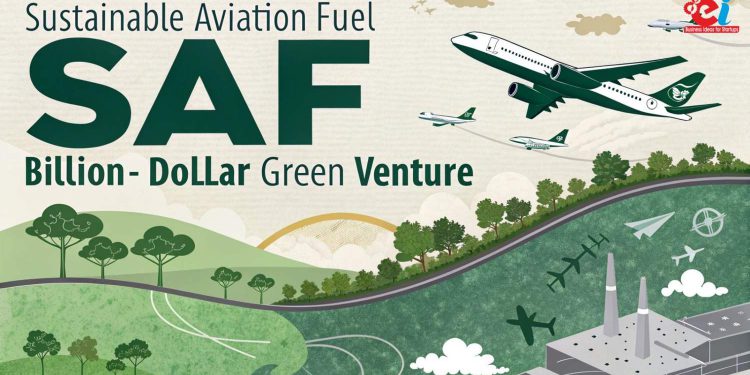Sustainable Aviation Fuel (SAF) captures harmful carbon emissions while permitting current commercial airliners to use their engines without major alterations. In respect of environmental guidelines while promoting biomaterials and waste raw materials, SAF holds the possibility of boosting economic growth by innovation, localization on a vast scale. The broadened use of SAF incorporates birds-eye view regulations aimed by international aviation authorities.
Due to the lack of Sustainable Aviation Fuel or other instantaneous patented solutions, air traffic today accounts for approximately 2 to 3 percent of the world’s carbon dioxide emissions. If no mitigative actions are executed, this number will double by 2040, surpassing the 5% mark. Aggressive policies alongside heightened consumer vigilance related to climate change are pushing the aviation industry against the wall, forcing them into the unforgiving race in the decarbonizing journey.
The prospects of Sustainable Aviation Fuel were noted in the June 3, 2025 edition of Chemical Weekly as the golden fix for emission-related issues in the aviation industry.
AMOCO’s invention of Sustainable Aviation Fuel from renewable biomass and waste materials makes its GHG emission equivalent reach astounding levels of up to 80% reduction in comparison to conventional jet fuels. With these solid plans from IATA and ICAO aligned towards adoption and acceptance from flight companies globally, this marks the transition of Sustainable Aviation Fuel from being merely a pilot venture project to one soaring into the billion-dollar sustainable initiative ventures.
The finest candidates to fill the scopes of Indian entrepreneurialism and innovation start-ups with localization strategy are abundantly available in this sector.
Primary Sustainable Aviation Fuel Feedstocks
- Used cooking oil, tallow, and lard
- Agricultural and forestry waste products (lignocellulosic biomass)
- Algae and microalgae
- Municipal solid waste (MSW)
- Industrial off-gas CO₂
- Green hydrogen, Fischer-Tropsch synthesis (Power-to-Liquid)
Production Pathways
- HEFA-SPK – Hydroprocessed esters and fatty acids
- FT-SPK – Fischer-Tropsch synthetic paraffinic kerosene
- ATJ-SPK – Alcohol-to-Jet
- Hydrothermolytic catalytic jet (CHJ)
- Power-to-Liquid (PtL) with renewable electricity
Related: The Rise of Bioenergy: Can India Lead the Next Renewable Energy Wave?
Market Overview and Global Initiatives
The global market for SAF was worth approximately $1.3 billion in 2023 and will likely surpass $30 billion by 2030, growing at a rate higher than 60% per year. SAF is expected to account for around 65% of emissions reduction funding required from aviation to achieve net zero in 2050, according to the International Air Transport Association (IATA).
Key Global Developments
- EU increases blend requirement to 6% by 2030 under the ReFuelEU program
- US provides tax incentives for SAF under the Inflation Reduction Act
- Airlines like Lufthansa, United, and Emirates are increasing midstream capacity for SAF
India’s Contribution to SAF
India is one of the late starters, but it is catching up fast. India is endowed with biomass, agricultural residues, and industrial CO₂ emissions, providing an opportunity for indigenous SAF production development.
Chemicals Weekly (June 2025) notes that IndianOil, along with Praj Industries and CSIR-IIP, are collaboratively working towards building pilots for ethanol and biomass-based SAF. SAF Boeing has also shown interest towards building commercial-grade SAF plants.
Policy Initiatives
- The blending mandate by MoCA and MoPNG is set to begin in 2027, forecasting an initiation percentage of 1–2%
- GAIL along with IOCL is working on green hydrogen-fueled SAF under the National Green Hydrogen Mission
- Encouraging biofuel infrastructure on a state incentive level in Maharashtra and Gujarat
Startup and Entrepreneurial Opportunities
1. Supply Chain Solutions
Involving feedstock for biomass, UCO, and municipal solid waste processing hubs.
- Concept: Refiner-centered supply chain aggregator
- Example: Startups such as Waste2Fuel that gather UCO and tallow for HEFA refineries
2. Production Modules
Permit remote locations or those close to airports to be operated for containerized SAF production that rely on modular techniques.
- ATJ preferably focuses on ethanol-rich regions
- CHJ pushes into distilleries and sugar mills for SAF
3. SAF Ventures Using Algae
Food crops don’t compete with microalgae featuring high lipid productivity.
- Ary: Farming lipid-rich algae in saline or wastewater
- Collaborate with CSIR or private labs for strain modification
4. SAF Using Carbon Capture Technology (PtL)
Production of SAF from CO₂ captured from an industrial site combined with green hydrogen.
- Suitable for large-scale operations despite having a high capital expenditure
- Startup Role: Develop carbon capture membranes, electrolyzer innovation, or reactor design
5. SAF Testing and Certification
Every batch of SAF produced must be evaluated through proper testing.
- Each SAF batch is checked for compliance with ASTM D7566 standards
- Opportunity: Fuel testing NABL accredited laboratories located close to airports or production facilities
6. Platforms for the SAF Supply Chain
- Digital platforms can automate the process of procurement, compliance, and traceability for both SAF producers and users
- Implementation: Blockchain, IoT, and AI for carbon accounting
- SAF credits and compliance trading can be conducted using a marketplace model
Investment Landscape
There is growing interest SAF is receiving from investors, but it is still considered capital-intensive.
- The Indian SAF ecosystem received funding of over ₹800 crores in 2024
- Praj Industries, IndianOil R&D, and Blue Planet are key players, along with Boeing India
- Breakthrough Energy, Temasek, Eni Next, and Shell Ventures are prominent global investors
Challenges to Overcome
- Blending targets and taxation need regulatory clarity
- High cost, ranging from 2–4 times that of conventional jet fuel
- Limited certified feedstock resources
- Long offtake agreements with airlines are required
Startups, oil firms, OEMs, and even government departments need to collaborate to tackle and overcome these challenges.
Key Future Trends in Sustainable Aviation Fuel
- Catalytic Pyrolysis will enable co-processing SAF in existing refineries
- Short-Haul Flights will utilize hybrid SAF-electric propulsion
- DAC-integrated PtL SAF will enhance Direct Air Capture
- Biochar-linked pathways will sustain carbon-negative SAF
Conclusion
With expert predictions estimating India’s aviation sector to claim the third position globally in the coming years, and the already soaring global demand for SAF, it won’t be long till we see practical usage of Sustainable Aviation Fuel. The transition from preliminary to operational stages will occur extremely quickly.
To sum it up, Sustainable Aviation Fuel is a vital and warranted resource. Because of strong supportive policies, growing industry demand, and existing abundant resources, India is standing on the verge of an aviation revolution.
Startups have endless opportunities as SAF provides an interdisciplinary battlefield ranging from biotech, cleantech, synthetic chemistry, digital platforms, and even process engineering.
If we redirect our focus to sustainability integrated with mobility, aspiring entrepreneurs will not only ride the SAF wave but also help create a stable foundation for it.
From working on carbon marketplaces to green hydrogen synthesis, SAF is a tool that enables the construction of impactful, scalable, and profitable ventures on a global scale.
All we need to do is integrate these tools to protect the climate, and it won’t be long before we’ll be able to sustainably fuel our skies.


























